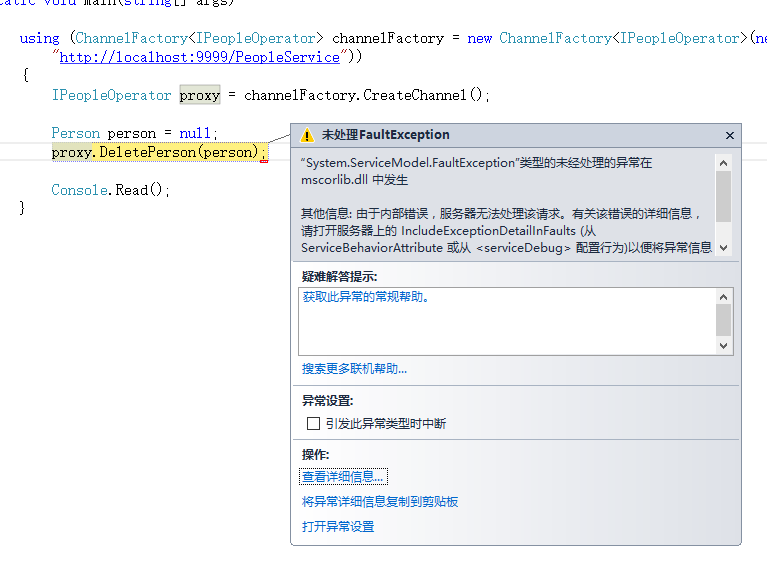There are two types of Execptions which can be throwed from the WCF service. They are Application excepiton and Infrastructure exception.
Handle Application Exception
If we do nothing, a FaultException always be throwed when your WCF service appear any error. For example:
Service:
using Service.Interface;
using Entities;
using System;
namespace Service
{
public class PeopleService : IPeopleOperator
{
public void DeletePerson(Person person)
{
Console.WriteLine("Have deleted a person whoes name is:" + person.Name);
}
}
}Client:
using Entities;
using Service.Interface;
using System;
using System.ServiceModel;
namespace Client
{
class Program
{
static void Main(string[] args)
{
using (ChannelFactory<IPeopleOperator> channelFactory = new ChannelFactory<IPeopleOperator>(new WSHttpBinding(),
"http://localhost:9999/PeopleService"))
{
IPeopleOperator proxy = channelFactory.CreateChannel();
Person person = null;
proxy.DeletePerson(person);
Console.Read();
}
}
}
}When you run the Client code:

There is no useful information. We should use Fault Contract. Fault Contract allow developer define error information entity flexible.
Using Fault Contract
Create an Error message container entity
using System.Runtime.Serialization;
namespace Entities
{
[DataContract]
public class ErrorInformation
{
public ErrorInformation(string messages,
string serviceName,
string methodName)
{
Messages = messages;
ServiceName = serviceName;
MethodName = methodName;
}
[DataMember]
public string Messages { get; private set; }
[DataMember]
public string ServiceName { get; private set; }
[DataMember]
public string MethodName { get; private set; }
}
}Apply FaultContract attribute on the operation of the contract interface
using Entities;
using System.ServiceModel;
namespace Service.Interface
{
[ServiceContract(Name = "PeopleOperatorService", Namespace ="http://zzy0471.cnblogs.com")]
public interface IPeopleOperator
{
[FaultContract(typeof(ErrorInformation))]
[OperationContract]
void DeletePerson(Person person);
}
}Mondify the Service Code
using Service.Interface;
using Entities;
using System;
using System.ServiceModel;
namespace Service
{
public class PeopleService : IPeopleOperator
{
public void DeletePerson(Person person)
{
if (person == null)
{
var error = new ErrorInformation("参数person为null",
"PeopleService",
"DeletePerson");
throw new FaultException<ErrorInformation>(error);
}
else
{
Console.WriteLine("Have deleted a person whoes name is:" + person.Name);
}
}
}
}Mondify the Clinet Code:
using Entities;
using Service.Interface;
using System;
using System.ServiceModel;
namespace Client
{
class Program
{
static void Main(string[] args)
{
using (ChannelFactory<IPeopleOperator> channelFactory = new ChannelFactory<IPeopleOperator>(new WSHttpBinding(),
"http://localhost:9999/PeopleService"))
{
IPeopleOperator proxy = channelFactory.CreateChannel();
Person person = null;
try
{
proxy.DeletePerson(person);
}
catch (FaultException<ErrorInformation> fe)
{
Console.WriteLine(fe.Detail.Messages + " in method " + fe.Detail.MethodName + " of service " + fe.Detail.ServiceName);
}
catch(FaultException)
{
Console.WriteLine("Unknow FaultException");
}
Console.Read();
}
}
}
}Handle Infrastructure Exception
Except application exceptions, some Infrastructure Exceptions occasionally occur. For example: communication error, which may occur because of network unavailability, an incorrect address, the host process not running, and so on. The second type of error is related to the state of the proxy
and the channels. So We need some more catch:
catch (CommunicationException ex)
{
Console.WriteLine("Communication error:" + ex.Message);
}
catch(ObjectDisposedException ex)
{
Console.WriteLine("The proxy is closed:" + ex.Message);
}
catch (InvalidOperationException ex)
{
Console.WriteLine("InvalidOperation:" + ex.Message);
}
catch(TimeoutException ex)
{
Console.WriteLine("Timeout:" + ex.Message);
}
catch(Exception)
{
Console.WriteLine("Unknow Infrastructure Exception ");
}Whole code of client:
using Entities;
using Service.Interface;
using System;
using System.ServiceModel;
namespace Client
{
class Program
{
static void Main(string[] args)
{
using (ChannelFactory<IPeopleOperator> channelFactory = new ChannelFactory<IPeopleOperator>(new WSHttpBinding(),
"http://localhost:9999/PeopleService"))
{
IPeopleOperator proxy = channelFactory.CreateChannel();
Person person = null;
try
{
proxy.DeletePerson(person);
}
//
// Application Exception
//
catch (FaultException<ErrorInformation> fe)
{
Console.WriteLine(fe.Detail.Messages + " in method " + fe.Detail.MethodName + " of service " + fe.Detail.ServiceName);
}
catch(FaultException)
{
Console.WriteLine("Unknow Application FaultException");
}
//
// Infrastructure Exception
//
catch (CommunicationException ex)
{
Console.WriteLine("Communication error:" + ex.Message);
}
catch(ObjectDisposedException ex)
{
Console.WriteLine("The proxy is closed:" + ex.Message);
}
catch (InvalidOperationException ex)
{
Console.WriteLine("InvalidOperation:" + ex.Message);
}
catch(TimeoutException ex)
{
Console.WriteLine("Timeout:" + ex.Message);
}
catch(Exception)
{
Console.WriteLine("Unknow Infrastructure Exception ");
}
Console.Read();
}
}
}
}That's all.




 本文介绍了Windows通信基础(WCF)服务中两种类型的异常处理:应用程序异常和基础设施异常。通过示例详细展示了如何使用FaultContract来定义错误信息实体,并提供丰富的异常处理策略。
本文介绍了Windows通信基础(WCF)服务中两种类型的异常处理:应用程序异常和基础设施异常。通过示例详细展示了如何使用FaultContract来定义错误信息实体,并提供丰富的异常处理策略。
















 3509
3509

 被折叠的 条评论
为什么被折叠?
被折叠的 条评论
为什么被折叠?








